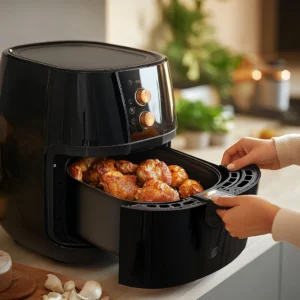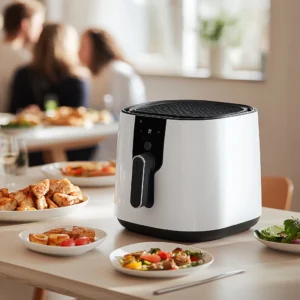In recent years, one cooking revolution that has gained widespread popularity is the airfryer. This innovative device has transformed the way home cooks achieve crispy textures and savory flavors while significantly reducing the use of oil.
With an emphasis on healthy cooking and efficiency, this appliance offers an alternative to traditional frying that does not compromise taste. Its advanced technology circulates heated air to cook food evenly, preserving nutrients and reducing calories.
For a deeper understanding of its origins and design, consider exploring the Air Fryer Overview on Wikipedia. This resource provides a historical perspective and detailed explanation of the mechanisms behind this modern cooking solution.
Key benefits of this technology include:
- Efficiency: Faster cooking times and energy savings.
- Versatility: Ideal for a range of recipes from snacks to full meals.
- Simplicity: User-friendly controls and minimal cleanup requirements.
This guide will walk you through every facet of this culinary innovation—from its fundamental technology and advantages to expert tips for choosing the right model, creative recipes, and proper maintenance. You will also find practical advice for troubleshooting common issues, ensuring that your kitchen remains at the forefront of modern culinary techniques.
What Is This Innovative Appliance?

Modern kitchens are increasingly embracing advanced cooking solutions that promise both convenience and improved nutritional outcomes. At its core, this appliance is engineered to mimic the results of deep frying using a fraction of the oil. Developed as a response to the growing demand for healthier meal preparation, it has evolved into a staple for many households.
Defining the Device
The airfryer employs rapid air technology to generate heat and circulate it at high speed. The result is a uniform cooking process that creates a crispy exterior without saturating food with fat. Unlike traditional deep-frying methods, the design focuses on retaining the natural flavors and textures of ingredients.
- Core Components:
- Heating Element: Provides consistent, controlled warmth.
- High-Speed Fan: Ensures even distribution of hot air.
- Removable Basket/Tray: Allows for optimal air circulation around food.
A Brief History
The journey of this cooking innovation began with the desire to produce healthier fried foods without sacrificing quality. Over time, improvements in digital controls and energy efficiency have refined the appliance’s performance, making it accessible to a broader audience.
The airfryer rise in popularity can be attributed to the modern consumer’s demand for convenience, health, and versatility in meal preparation.
For further context on how kitchen innovations have evolved over the decades, check out our internal article Our Complete History of Kitchen Gadgets. This resource delves into the evolution of modern appliances and highlights key milestones that have reshaped cooking practices.
The Evolution of Cooking Techniques
Traditional frying methods often relied on large quantities of oil to achieve a desirable texture. However, as nutritional awareness grew, so did the need for alternatives.
This appliance represents the convergence of technology and culinary art—providing a solution that marries efficiency with health-conscious cooking. Over time, additional features such as preset programs and digital interfaces have enhanced usability, making it a must-have tool in contemporary kitchens.
To understand more about the advances in cooking technology, you might explore our article on Modern Cooking Technologies, which outlines the latest trends and technological breakthroughs in home cooking.
How Does The airfryer Work?

The secret behind the success of this cooking gadget lies in its sophisticated heat distribution system. By using rapid air technology, it ensures that every morsel of food is cooked uniformly, achieving the desired crispiness without the need for deep immersion in oil.
The Science Behind Rapid Air Circulation
-
Heat Generation and Distribution:
The heating element quickly warms the air inside the appliance. Simultaneously, a high-speed fan propels this hot air in a circular motion, ensuring that heat is evenly distributed around the food. This mechanism not only cooks food faster but also locks in flavor and moisture. -
Temperature Control:
Digital sensors and preset functions allow for precise temperature regulation. This ensures that foods are not overcooked or undercooked, resulting in optimal texture and taste. The appliance’s design minimizes energy loss and maximizes cooking efficiency. -
Reduction of Oil Usage:
Traditional frying requires submerging food in oil, which can lead to high fat content. In contrast, this method uses only a minimal amount of oil—if any—making it an excellent choice for those seeking to maintain a healthier lifestyle.
Comparing Cooking Methods
While conventional deep frying often yields a delicious crunch, it comes at the cost of extra calories and health risks associated with high fat consumption. This technology achieves similar results by employing air circulation to mimic the effect of oil, thereby offering a healthier alternative without sacrificing the sensory experience of fried foods.
- Key Differences:
- Health Impact:
Reduced oil leads to lower calorie and fat intake. - Efficiency:
Faster cooking times and less energy consumption. - Ease of Use:
Simplified cleaning and maintenance routines.
- Health Impact:
In our internal piece Quick and Healthy Cooking, we further explore how modern cooking techniques are transforming everyday meal preparation into a healthier practice.
Before moving forward, consider how this innovation not only saves time but also adapts to a variety of culinary needs. Whether preparing a family dinner or a quick snack, the appliance’s versatility makes it an indispensable tool in contemporary kitchens.
Benefits of Healthier Frying
Embracing the airfryer offers numerous advantages that extend beyond the obvious appeal of reduced oil usage. Here are some of the key benefits:
Health Advantages
- Lower Calorie Intake:
By reducing the need for excessive oil, meals prepared with this method contain fewer calories, contributing to better overall nutrition. - Preservation of Nutrients:
The rapid cooking process helps maintain the integrity of vitamins and minerals that might otherwise be diminished by prolonged exposure to high heat. - Enhanced Heart Health:
A diet lower in unhealthy fats can lead to improved cardiovascular health, a critical factor for long-term well-being.
Efficiency and Convenience
- Faster Cooking Times:
The technology behind this device dramatically reduces cooking times compared to conventional ovens and deep fryers. - Energy Savings:
With optimized heat circulation and shorter cooking durations, energy consumption is notably lower. - Simplified Cleanup:
Removable parts that are often dishwasher-safe make post-cooking maintenance quick and hassle-free.
Versatility in the Kitchen
The airfryer excels in handling a broad spectrum of recipes, from savory appetizers to sweet desserts. Its adaptability means that it is no longer confined to merely replicating fried foods. Today’s culinary enthusiasts use it for:
- Roasting:
Achieving a golden-brown finish on vegetables and meats. - Baking:
Preparing treats like muffins, cookies, and even small cakes. - Grilling:
Simulating the effects of outdoor grilling indoors.
For more ideas on incorporating these benefits into your daily routine, take a look at our guide on Healthy Meal Planning.
Choosing the Right Device: A Buying Guide
Selecting the ideal model requires careful consideration of various factors to ensure that the appliance meets your cooking needs and fits within your budget.
Key Considerations
- Capacity:
Determine the right size based on the number of servings you typically prepare. For families or frequent entertainers, a larger capacity model might be ideal. - Power and Wattage:
Higher wattage models typically offer faster cooking times and may provide more consistent results. - Digital Features:
Look for models with user-friendly interfaces, preset programs, and precise temperature controls. - Safety Mechanisms:
Features such as auto shut-off and cool-touch exteriors are crucial for ensuring safe operation. - Price and Warranty:
Balance cost with the available features and check for warranties that offer peace of mind.
Tips for Making an Informed Purchase
- Consumer Reviews:
Research feedback from other users to gauge reliability and performance. - Side-by-Side Comparisons:
Compare specifications across models to identify the best fit for your kitchen. - Promotions and Discounts:
Keep an eye on seasonal sales that may offer substantial savings.
For detailed comparisons and expert recommendations, visit our internal resource airfryer buying guide. This article provides an in-depth look at the latest models and helps you navigate through the numerous options available on the market.
It is important to weigh these factors carefully to ensure that your purchase aligns with both your culinary habits and lifestyle preferences.
Recipes and Cooking Tips

One of the most exciting aspects of adopting the airfryer is the creative freedom it brings to the kitchen. With its ability to deliver perfectly crisp results using minimal oil, the possibilities for healthy and delicious recipes are nearly endless. For instance, you can experiment with classic dishes like crispy French-style fries or golden chicken wings, and even try innovative creations such as airfryer-grilled cheese.
If you are looking to expand your culinary repertoire, be sure to check out our Air Fryer Grilled Cheese recipe, which offers a delightful twist on a traditional favorite.
When using your airfryer, it is essential to preheat the appliance to ensure even cooking and to avoid overcrowding the basket so that the hot air can circulate freely. A light spritz of oil and a careful selection of spices can elevate the taste of your dishes while keeping them low in fat. Whether you are preparing a family dinner or a quick snack, the airfryer adapts to a variety of culinary needs, making it an indispensable tool in any kitchen.
Popular Recipe Ideas
- Crispy French-Style Fries:
Achieve the perfect balance of crunch and tenderness with a fraction of the oil. - Golden Chicken Wings:
Enjoy a healthier version of a favorite appetizer without compromising on flavor. - Vegetable Medleys:
Roast an assortment of vegetables to a delightful crisp, preserving their natural sweetness. - Baked Desserts:
Experiment with recipes for muffins, cookies, or small cakes that come out delightfully moist.
Essential Cooking Techniques
- Preheating is Key:
Always allow the appliance to reach the optimal temperature before adding your ingredients. This step is crucial to ensure even cooking. - Light Oil Spritz:
A fine mist of oil combined with your favorite spices can enhance flavor while keeping meals low in fat. - Avoid Overcrowding:
To achieve the best texture, arrange food in a single layer, allowing hot air to circulate freely. - Experiment with Presets:
Familiarize yourself with the built-in programs to find the perfect settings for different recipes.
Detailed Cooking Tips
- Batch Cooking:
If preparing a large quantity, cook in batches to avoid compromising the crispiness of the final dish. - Temperature Adjustments:
Minor adjustments in temperature and timing can make a significant difference, especially when trying new recipes. - Creative Sauces:
Complement your dishes with homemade dips and sauces that are low in calories yet high in flavor.
For a broader range of culinary inspirations, check out our collection of airfryer recipes, which offers step-by-step guides for creating delectable dishes suited for every occasion.
Using this cooking gadget effectively can open up a world of healthy alternatives without sacrificing the pleasures of your favorite comfort foods.
Maintenance and Troubleshooting
Proper care and routine maintenance ensure that your airfryer remains in top condition for years to come. Regular cleaning and timely troubleshooting can prevent performance issues and extend the lifespan of this cooking device.
Daily and Periodic Cleaning
- Wipe Down After Each Use:
After cooking, clean the exterior with a damp cloth to remove grease and residue. - Clean Removable Parts:
The basket or tray should be washed after every use, preferably in warm, soapy water. Many components are dishwasher-safe for added convenience. - Deep Cleaning:
Periodically, disassemble removable parts to thoroughly clean hard-to-reach areas. Avoid abrasive cleaners that might damage the surface.
Troubleshooting Common Issues
- Uneven Cooking:
Ensure food is not overcrowded and that the appliance is preheated properly. Revisit the user manual for guidance on optimal load capacity. - Error Messages:
Consult the troubleshooting section of the manual. Often, a simple reset or cleaning of the sensor areas resolves minor issues. - Performance Lapses:
Check for dust or residue around the fan and heating element. Regular cleaning can prevent these common problems.
For additional maintenance tips, please see our internal guide on airfryer maintenance tips, which offers practical advice to keep your appliance running smoothly.
FAQs: Common Questions About This Cooking Device
Below are some frequently asked questions designed to address common concerns and enhance your overall cooking experience.
-
How does this appliance cook food so efficiently?
It utilizes rapid air circulation to evenly distribute heat, ensuring that food is cooked uniformly with a minimal amount of oil. -
Is it healthier than traditional frying methods?
Yes. By significantly reducing oil usage, meals prepared with this technology tend to be lower in calories and fat, contributing to a more balanced diet. -
Can frozen foods be prepared using this device?
Absolutely. The precise temperature controls allow for the safe and effective cooking of frozen items without compromising quality. -
What is the best way to clean the appliance?
Regular cleaning of removable parts and a simple wipe-down of the exterior are recommended. Detailed cleaning instructions can be found in the user manual. -
Are there preset programs for different types of food?
Most modern models come with a variety of presets designed to optimize cooking for different recipes and food types.
Conclusion
In summary, this advanced cooking solution represents a significant leap forward in the realm of healthy meal preparation. By harnessing rapid air technology, it delivers the satisfying crunch of fried foods while minimizing the need for excessive oil. Whether you are a busy professional or a culinary enthusiast, this appliance can elevate your kitchen routine through its efficiency, versatility, and ease of use.
Choosing the right model and following proper maintenance guidelines will ensure that you enjoy delicious, healthier meals for years to come. As you continue to explore new recipes and cooking techniques, remember that innovation in the kitchen is key to maintaining both health and flavor. Embrace this technology and experience a new standard in modern cooking.

